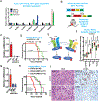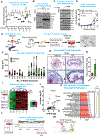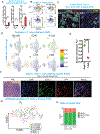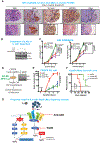Oncogenic KRAS-Driven Metabolic Reprogramming in Pancreatic Cancer Cells Utilizes Cytokines from the Tumor Microenvironment
- PMID: 32046984
- PMCID: PMC7125035
- DOI: 10.1158/2159-8290.CD-19-0297
Oncogenic KRAS-Driven Metabolic Reprogramming in Pancreatic Cancer Cells Utilizes Cytokines from the Tumor Microenvironment
Abstract
A hallmark of pancreatic ductal adenocarcinoma (PDAC) is an exuberant stroma comprised of diverse cell types that enable or suppress tumor progression. Here, we explored the role of oncogenic KRAS in protumorigenic signaling interactions between cancer cells and host cells. We show that KRAS mutation (KRAS*) drives cell-autonomous expression of type I cytokine receptor complexes (IL2rγ-IL4rα and IL2rγ-IL13rα1) in cancer cells that in turn are capable of receiving cytokine growth signals (IL4 or IL13) provided by invading Th2 cells in the microenvironment. Early neoplastic lesions show close proximity of cancer cells harboring KRAS* and Th2 cells producing IL4 and IL13. Activated IL2rγ-IL4rα and IL2rγ-IL13rα1 receptors signal primarily via JAK1-STAT6. Integrated transcriptomic, chromatin occupancy, and metabolomic studies identified MYC as a direct target of activated STAT6 and that MYC drives glycolysis. Thus, paracrine signaling in the tumor microenvironment plays a key role in the KRAS*-driven metabolic reprogramming of PDAC. SIGNIFICANCE: Type II cytokines, secreted by Th2 cells in the tumor microenvironment, can stimulate cancer cell-intrinsic MYC transcriptional upregulation to drive glycolysis. This KRAS*-driven heterotypic signaling circuit in the early and advanced tumor microenvironment enables cooperative protumorigenic interactions, providing candidate therapeutic targets in the KRAS* pathway for this intractable disease.
©2020 American Association for Cancer Research.
Conflict of interest statement
Disclosure of Potential Conflicts of Interest
R.A.D. is a co-founder, advisor and director of Tvardi Therapeutics, Asylia Therapeutics, and Nirogy Therapeutics. The work of this paper is not connected with the focus on these biotechnology companies.
Figures






Similar articles
-
KRAS-Driven Tumorigenesis and KRAS-Driven Therapy in Pancreatic Adenocarcinoma.Mol Cancer Ther. 2024 Oct 1;23(10):1378-1388. doi: 10.1158/1535-7163.MCT-23-0519. Mol Cancer Ther. 2024. PMID: 39118358 Free PMC article. Review.
-
Nuclear Galectin-1 promotes KRAS-dependent activation of pancreatic cancer stellate cells.Proc Natl Acad Sci U S A. 2025 Apr 8;122(14):e2424051122. doi: 10.1073/pnas.2424051122. Epub 2025 Apr 2. Proc Natl Acad Sci U S A. 2025. PMID: 40172967
-
Nicotine promotes initiation and progression of KRAS-induced pancreatic cancer via Gata6-dependent dedifferentiation of acinar cells in mice.Gastroenterology. 2014 Nov;147(5):1119-33.e4. doi: 10.1053/j.gastro.2014.08.002. Epub 2014 Aug 12. Gastroenterology. 2014. PMID: 25127677
-
Extrinsic KRAS Signaling Shapes the Pancreatic Microenvironment Through Fibroblast Reprogramming.Cell Mol Gastroenterol Hepatol. 2022;13(6):1673-1699. doi: 10.1016/j.jcmgh.2022.02.016. Epub 2022 Mar 1. Cell Mol Gastroenterol Hepatol. 2022. PMID: 35245687 Free PMC article.
-
Interplays of glucose metabolism and KRAS mutation in pancreatic ductal adenocarcinoma.Cell Death Dis. 2022 Sep 24;13(9):817. doi: 10.1038/s41419-022-05259-w. Cell Death Dis. 2022. PMID: 36151074 Free PMC article. Review.
Cited by
-
Co-expression patterns explain how a basic transcriptional role for MYC modulates Wnt and MAPK pathways in colon and lung adenocarcinomas.Cell Cycle. 2022 Aug;21(15):1619-1638. doi: 10.1080/15384101.2022.2060454. Epub 2022 Apr 19. Cell Cycle. 2022. PMID: 35438040 Free PMC article.
-
Obesity and Pancreatic Cancer: Insight into Mechanisms.Cancers (Basel). 2021 Oct 10;13(20):5067. doi: 10.3390/cancers13205067. Cancers (Basel). 2021. PMID: 34680216 Free PMC article. Review.
-
Targeting KRAS for the potential treatment of pancreatic ductal adenocarcinoma: Recent advancements provide hope (Review).Oncol Rep. 2023 Nov;50(5):206. doi: 10.3892/or.2023.8643. Epub 2023 Oct 6. Oncol Rep. 2023. PMID: 37800636 Free PMC article. Review.
-
KRAS mutation: The booster of pancreatic ductal adenocarcinoma transformation and progression.Front Cell Dev Biol. 2023 Apr 20;11:1147676. doi: 10.3389/fcell.2023.1147676. eCollection 2023. Front Cell Dev Biol. 2023. PMID: 37152291 Free PMC article. Review.
-
Molecular Imaging: Unveiling Metabolic Abnormalities in Pancreatic Cancer.Int J Mol Sci. 2025 May 29;26(11):5242. doi: 10.3390/ijms26115242. Int J Mol Sci. 2025. PMID: 40508051 Free PMC article. Review.
References
-
- Clark CE, et al. Dynamics of the immune reaction to pancreatic cancer from inception to invasion. Cancer Res 67, 9518–9527 (2007). - PubMed
Publication types
MeSH terms
Substances
Grants and funding
LinkOut - more resources
Full Text Sources
Other Literature Sources
Medical
Molecular Biology Databases
Research Materials
Miscellaneous

